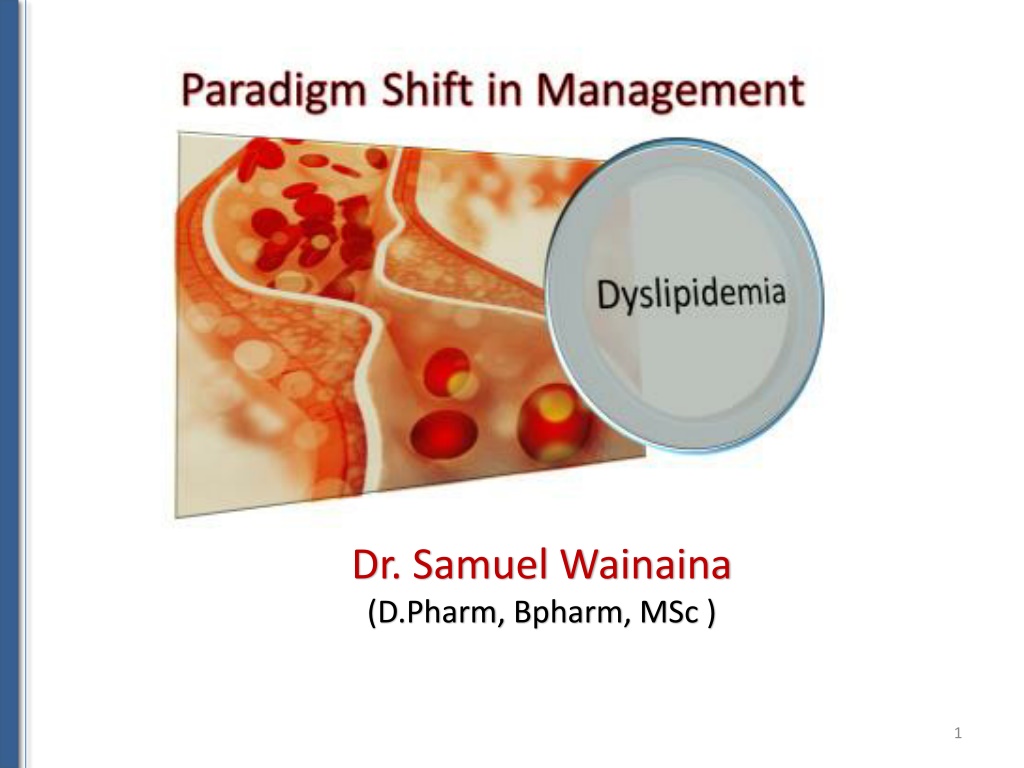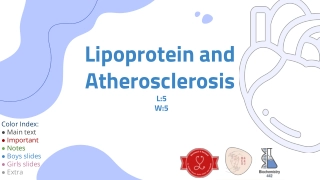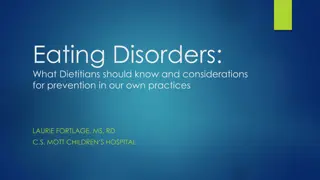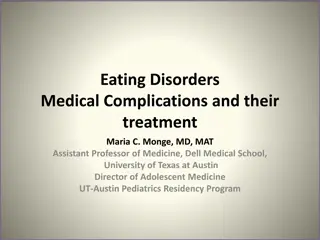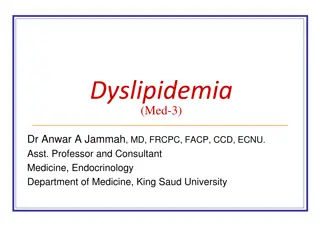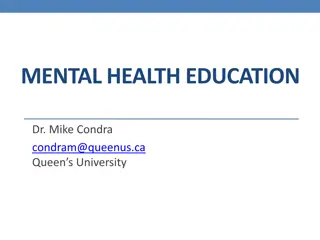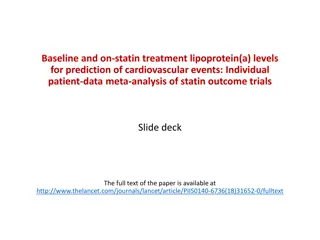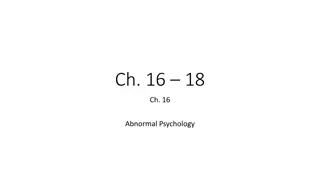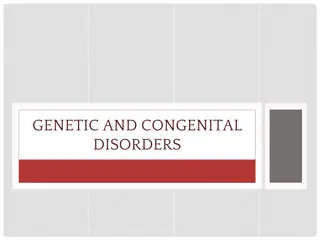Understanding Dyslipidemia and Lipoprotein Disorders
Plasma lipids are transported in complexes called lipoproteins. Dyslipidemia, characterized by elevated cholesterol, triglycerides, or low HDL cholesterol, is a major risk factor for cardiovascular diseases. Learn about lipid metabolism, dyslipidemia management approaches, and the role of pharmacy professionals in controlling infestations.
Download Presentation

Please find below an Image/Link to download the presentation.
The content on the website is provided AS IS for your information and personal use only. It may not be sold, licensed, or shared on other websites without obtaining consent from the author. Download presentation by click this link. If you encounter any issues during the download, it is possible that the publisher has removed the file from their server.
E N D
Presentation Transcript
Dr. Samuel Wainaina (D.Pharm, Bpharm, MSc ) 1
Outline 1.Introduction 2.Definition of terminologies 3.Lipoprotein disorders 4.Types of dyslipidemia 5.Approaches to Management 6.Roleandresponsibility of pharmacy professionals in Infestation control 6.Summary 2
Objectives Describe lipid metabolism Explain various approaches to management of Dyslipidemia Sate personal responsibility in reducing the risk of dyslipidemia and CHD 3
Introduction Plasma lipids are transported in complexes called lipoproteins Metabolic disorders of elevated of lipoproteins are called hyperlipoproteinemia or hyperlipidemias Hyperlipemia denotes hypertriglyceridemia or increased levels if triglycerides Hyperlipemia is a risk factor of acute pancreatitis Hyperlipoproteinemia precipitates atherosclerosis Dyslipidemia is Major risk factor in CVDs. 4
What is Dyslipidemia? Definition: Dyslipidemia is elevation of plasma cholesterol, triglycerides (TGs), or both, or a low HDL cholesterol level that contributes to the development of atherosclerosis 5
Do we need Cholesterol? 1. It s a Component of cell membranes 2. Synthesis of certain hormones 3. synthesis of bile salts 4. Reducing evaporation at stratum corneum 5. blocks transdermal absorption of water-soluble compounds 6
Increased ingestion of cholesterol inhibits endogenous cholesterol synthesis Sources of Cholesterol Exogenous Increase in dietary saturated fats produces a substantial (15% to 25%) increase in circulating cholesterol Because the liver uses saturated fats to make cholesterol More cholesterol comes from endogenous Synthesis than from the diet Endogenous Synthesis is catalyzed by HMGCoA reductase 7
How Is Cholesterol Transported? Lipoproteins serve as carriers for transporting lipids cholesterol and triglycerides in blood Tiny, spherical structures Hydrophobic core, composed of cholesterol and triglycerides, surrounded by a hydrophilic shell 8
Apolipoproteins. They constitute the protein component of lipoproteins, have three functions: 1. They serve as recognition sites for cell- surface receptors, and thereby allow cells to bind with and ingest lipoproteins. 2. They activate enzymes that metabolize lipoproteins. 3. They increase the structural stability of lipoproteins 9
Notable Facts The apolipoproteins of greatest clinical interest are labeled A-I, A-II, and B-100. Lipoproteins with apolipoprotein B-100 take cholesterol to Tissues Lipoproteins with apolipoprotein A-I take cholesterol from tissues 10
Classes of Lipoproteins There are six major classes of plasma lipoproteins. Naming of lipoprotein types is based on their density. Classes of lipoproteins differ in density because they differ in their percent composition of lipid and protein. Because protein is denser than lipid, lipoproteins that have a high percentage of protein (have a relatively high density. lipoproteins with a lower percentage of protein have a lower density. 11
Types of Lipoproteins Intermediaries Chylomicrons Chylomicron remnants Intermediate Density Lipoproteins (IDL) Important in Coronary Atherosclerosis Very-Low Density Lipoproteins Low Density Lipoproteins( Bad Cholesterol) High Density Lipoproteins (Good Cholesterol) 12
Physiologic Roles VLDLs -deliver triglycerides from the liver to adipose tissue and muscle. LDL -delivers cholesterol to nonhepatic tissues Itmakes the greatest contribution to coronary atherosclerosis. When cellular demand for cholesterol increases, cells synthesize more LDL receptors and thereby increase their capacity for LDL uptake. Cells that are unable to make more LDL receptors cannot increase cholesterol absorption 13
HDLs -carry cholesterol from peripheral tissues back to the liver. Therefor HDLs promote cholesterol removal Not all HDL particles are the same. Some contain only apolipoprotein A-I, whereas others contain apolipoproteins A-I and A-II. Cardioprotection is conferred by the HDLs that contain only apolipoprotein A-I. 14
Steps of Atherosclerosis LDL Transport to endothelial Cells LDL reached Sub- endothelial Space LDL Undergoes Oxidation Macrophages mobility become inhibited Monocyte s converted to macrophages Monocytes migrate to Sub-endothelial Space The material become cytotoxic and damage the endothelium Oxidized LDL undergo Uptake by macrophages Platelet Adhesion and formation of microthrombi 15
Causes of Dyslipidemia Genetic Causes(Familial Disorders) Multiple gene mutations that result in either overproduction or defective clearance of triglycerides and LDL, or in underproduction or excessive clearance of HDL Primary Causes A sedentary lifestyle with excessive dietary intake of total calories, saturated fat, cholesterol, and trans fats Diabetes Alcohol overindulgence Drugs Hypothyroidism Secondary Causes 16
Detection & Evaluation Lipoprotein disorders are detected by lipids in serum after a 10-hour fast. Risk of heart disease is concentration of artherogenic lipoproteins. Risk of CHD is inversely related to levels of HDL Differentiation of familial disorders is by identification of Lipoproteins involved. 17
Serum Levels of Lipoproteins Desirable Borderline to high High Total Cholesterol <200mg/dL 200-239mg/dL >240mg/dL LDL-Cholesterol <130mg/dL 130-159mg/dL >160mg/dL HDL- Cholesterol >60mg/dL Men >40mg/dL Women >50mg/dL Triglycerides <120mg/dL 120-199mg/dL >200mg/dL 18
Approaches to Management Therapeutic Lifestyle Change Pharmacotherapy 2nd Line To TLC Diet Weight Control In TLC Failure Elevated+ CHD Risks Exercise 19
Therapeutic Lifestyle Change The TLC Diet. This diet has two objectives: 1. Reducing LDL cholesterol and 2. Establishing and maintaining a healthy weight The diet reduces intake of cholesterol and saturated fats: limit intake of cholesterol to 200 mg/day or less and intake of saturated fat to 7% or less of total calories. Minimize Intake of trans fats (Crackers, Commercial baked foods and French fries) Increased intake of soluble fiber (Oatmeal) Increased intake of plant stanols and sterols 20
Weight Control Chronic, excessive intake of calories leads to increased concentrations of triglycerides and reduced HDL-C. Maintain ideal body weight (BMI 20 25 kg/m2) The Weight loss can reduce both LDL cholesterol and CHD risk Lipoproteins with apolipoprotein A-I take cholesterol from tissues 21
Exercise Regular exercise lowers CHD risk Running & Swimming decrease LDL-C and elevate HDL-C Exercise can also reduce blood pressure, decrease insulin resistance, and improve overall CV performance 22
Smoking Cessation Smoking Raises LDL-C and Lowers HDL-C HDL-C LDC-C Hence increasing the risk of CHD. Smokers should be strongly encouraged to quit Nonsmokers should be urged not to start 23
Drug Therapy Drugs are not the first-line therapy for lowering LDL cholesterol. Should only be used if TLCs fail to reduce LDL cholesterol to an acceptable Dietary modification should continues. Why? Because the beneficial effects of diet and drugs are additive Drugs alone may be unable to achieve the LDL goal. 24
Classification 1. HMG-CoA reductase inhibitors (Statins):Lovastatin, Simvastatin, Pravastatin, Atorvastatin, Rosuvastatin, Pitavastatin 2. Bile acid sequestrants (Resins):Cholestyramine, Colestipol, Colesevelam 3. Lipoprotein lipase activators (Fibrates): Clofibrate, Gemfibrozil, Bezafibrate, Fenofibrate. 4. Lipolysis and triglyceride synthesis inhibitor (Nicotinic acid). 5. Sterol absorption inhibitor: (Ezetimibe). 25
Class M.O.A Effects Application Toxicity & interactions STATINS -Artovastatin -Simvastatin -Rosuvastatin Inhibit HMG-CoA reductase Reduce cholesterol synthesis Up-regulate LDL- Rcpts Reduce triglycerides Artherosclerosis Acute Coronary Syndrome Myopathy Hepatotoxicity Interact with CYP Inhibitors FIBRATES -Fenofibrate -Gemfibrozil Peroxisome proliferator- activated receptor alpha (PPAR-a) agonists Decrease secretion of VLDL Increase lipoprotein lipase activity Increase HDL Hypertriglyceridemia Low HDL Myopathy Hepatic dysfunction BILE ACID SEQUESTRANTS -Colestipol -Cholestyramine -Colesevelam Binds bile acids in gut -prevents reabsorption -Increase cholesterol catabolism -Upregulate LDL receptors Decrease LDL Elevated LDL Digitalis toxicities Pruritus Constipation Bloating Interferes absorption of some drugs and vitamins STEROL ABSORTION INHIBITORS -Ezetimibe Bloack sterol transporter in intestine brush boerders Inhibits reabsorption of cholesterol excreted in bile. -decrease LDL and Cholesterol Elevated LDL Phytosterolemia Myositis Low incidences of hepatic dysfunction NIACIN Decrease catabolism of of apo A-I Reduces VLDL secretion from the Liver Increase HDL Decrease Lipoprotein(a), LDL and triglycerides Low HDL Elevated VLDL Elevated LDA Elevated Lp(a) Gastric irritation Flushing May reduce glucose tolerance 27
Combined Drug Therapy Combines drug therapy is useful 1) When VLDL levels are significantly increased during treatment of hypercholesterolemia with a resin 2) When LDL and VLDL are both elevated initially 3) When LDL or VLDL levels are not normalized with a single agent 4) When elevated level of Lp (a) or an HDL deficiency coexist with other hyperlipidemia. 28
Fibrates & Bile Acid Binding Resins Use in treating Patients with familial Combined hyperlipidemia who are intolerant of niacin or statins. NOTE: It may increase the the risk of Cholelithiasis 29
Statins & Bile Acid Binding Resins Useful in the treatment of familial hypercholesterolemia but may not control levels of VLDL in some patients with familial combined hyperlipoproteinemia. Statins should be given 1 hour before or 4 hours after the resin to ensure absorption 30
Pharmacy professionals Role and Responsibilities Educate on prevention and control Offer advice on Therapeutic Lifestyle Change Encourage detection and evaluation Carry out medication Therapy Management 31
ThankYou! 32
